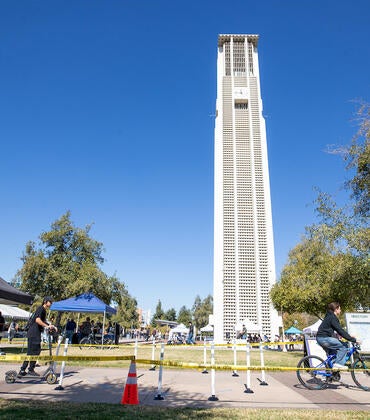Pedestrians who walk by parking lot 24 now have a row of newly planted pomegranate trees to admire – and eventually supply them with fruit.
John Chater, a postdoctoral researcher with UC Riverside's Department of Botany and Plant Sciences and a 2016 University of California Global Food Initiative fellow, brought the first 13 trees to lot 24 on a recent weekday. The intention behind this project, the first of two phases, is to make pomegranates – a nutrient-dense fruit – accessible to the campus community. Eventually, lot 24 will have a total of 25 trees.
The first set of trees were planted on April 20 with the help of four students and the collaboration of UCR’s Transportation and Parking Services, known as TAPS, as well as with Facilities Services. The teams helped Chater decide where these drought-tolerant trees would have more impact, and by clearing the ornamental landscape that existed on the south side of the lot where half of the trees now sit.
“I called to see how they could help, and immediately received their support,” said Chater, referring to TAPS and Facilities Services. Chater researches several varieties of pomegranates, and part of his Global Food Initiative work also requires that he make his research available for consumption, he said. He’s been working alongside Zhenyu “Arthur” Jia, assistant professor of Botany and Plant Sciences; and Donald Merhaut, UC Cooperative Extension specialist for ornamental and floriculture crops; both of whom have also offered guidance.
“The intention is to contribute to the campus and make it more beautiful,” said Jia. “Also, to offer another fruit in addition to citrus that UCR is known for. We want the campus community to know we also do research on pomegranates. We want to increase the awareness of this important fruit.”
Merhaut said Chater, who now leads a multi-state grant request from the United States Department of Agriculture, has been doing great work.
“He’s really passionate about what he does,” Merhaut said.
Chater said pomegranates are high in antioxidants, filled with potassium, and have vitamin C, A, and E. They also make great snack options, he said. Helping consumers — who often think of pomegranates as bitter, difficult to peel, and filled with hard seeds — learn more about their varieties, textures, and flavors, will help commercialize the fruit.
Pomegranates actually come in various colors and sizes, and their flavors vary from sweet/tart, to tasting almost like an apple or a pear, Chater said. Plus, having these trees in lot 24 is a way of having “a nice interface as students walk back and forth to campus.”
To make sure the trees grow in a healthy state, landscapers such as Mark Jones, a landscape supervisor with Facilities Services, will be paying close attention to the amount of water they receive.
Pomegranate varieties in lot 24 will include: Wonderful, Purple Heart, Parfianka, Haku Botan, Eversweet, Blaze, and Phoenicia.




